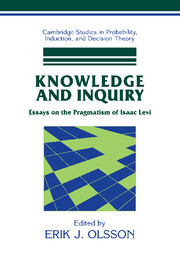Book contents
- Frontmatter
- Contents
- List of Contributors
- Preface
- Introduction: The Pragmatism of Isaac Levi
- 1 Isaac Levi and His Pragmatist Lineage
- 2 Is Pragmatist Truth Irrelevant to Inquiry?
- 3 The Knowledge Business
- 4 Infallibility and Incorrigibility
- 5 Why Inconsistency Is Not Hell: Making Room for Inconsistency in Science
- 6 Levi on Risk
- 7 Vexed Convexity
- 8 Levi's Chances
- 9 Isaac Levi's Potentially Surprising Epistemological Picture
- 10 Isaac Levi on Abduction
- 11 Potential Answers – To What Question?
- 12 Levi and the Lottery
- 13 The Value of Truth and the Value of Information: On Isaac Levi's Epistemology
- 14 Decision-Theoretic Contraction and Sequential Change
- 15 Deciding What You Know
- 16 Levi's Ideals
- 17 The Mind We do Not Change
- 18 Psychoanalysis as Technology
- 19 Levi on Money Pumps and Diachronic Dutch Books
- 20 Levi on the Reality of Dispositions
- 21 Replies
- Index
- References
16 - Levi's Ideals
Published online by Cambridge University Press: 05 March 2010
- Frontmatter
- Contents
- List of Contributors
- Preface
- Introduction: The Pragmatism of Isaac Levi
- 1 Isaac Levi and His Pragmatist Lineage
- 2 Is Pragmatist Truth Irrelevant to Inquiry?
- 3 The Knowledge Business
- 4 Infallibility and Incorrigibility
- 5 Why Inconsistency Is Not Hell: Making Room for Inconsistency in Science
- 6 Levi on Risk
- 7 Vexed Convexity
- 8 Levi's Chances
- 9 Isaac Levi's Potentially Surprising Epistemological Picture
- 10 Isaac Levi on Abduction
- 11 Potential Answers – To What Question?
- 12 Levi and the Lottery
- 13 The Value of Truth and the Value of Information: On Isaac Levi's Epistemology
- 14 Decision-Theoretic Contraction and Sequential Change
- 15 Deciding What You Know
- 16 Levi's Ideals
- 17 The Mind We do Not Change
- 18 Psychoanalysis as Technology
- 19 Levi on Money Pumps and Diachronic Dutch Books
- 20 Levi on the Reality of Dispositions
- 21 Replies
- Index
- References
Summary
INTRODUCTION
Isaac Levi's work has had what seems to be a lasting impact on several fields of philosophical inquiry. I am myself one of the many philosophers on whom he has had a decisive influence. His book Gambling with Truth was one of the major inspirations that led me to study philosophy, and I have continued to be an eager reader of his books and articles.
In this contribution I focus on Isaac Levi's choice of formal structures for the representation of beliefs. This aspect of his work exemplifies his influence; a large group of reseachers in decision theory and formal epistemology have either followed his proposals or taken them as starting points for their own developments. Since philosophy proceeds by criticism rather than by praise, I focus on what I perceive as possible problems and needs for clarification.
TWO TYPES OF IDEALIZATION
The representation of philosophical subject matter in formal language is always the outcome of an idealization. There are two types of idealization that should be carefully distinguished between, although they are often intertwined. First, to idealize can mean to simplify for the sake of clarity. The resulting formal model is an ideal in the sense of “[s]omething existing only as a mental conception” (Oxford English Dictionary).
- Type
- Chapter
- Information
- Knowledge and InquiryEssays on the Pragmatism of Isaac Levi, pp. 241 - 247Publisher: Cambridge University PressPrint publication year: 2006
References
- 4
- Cited by



